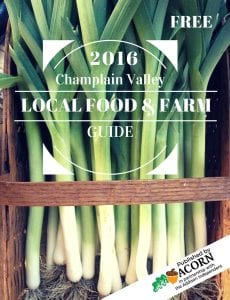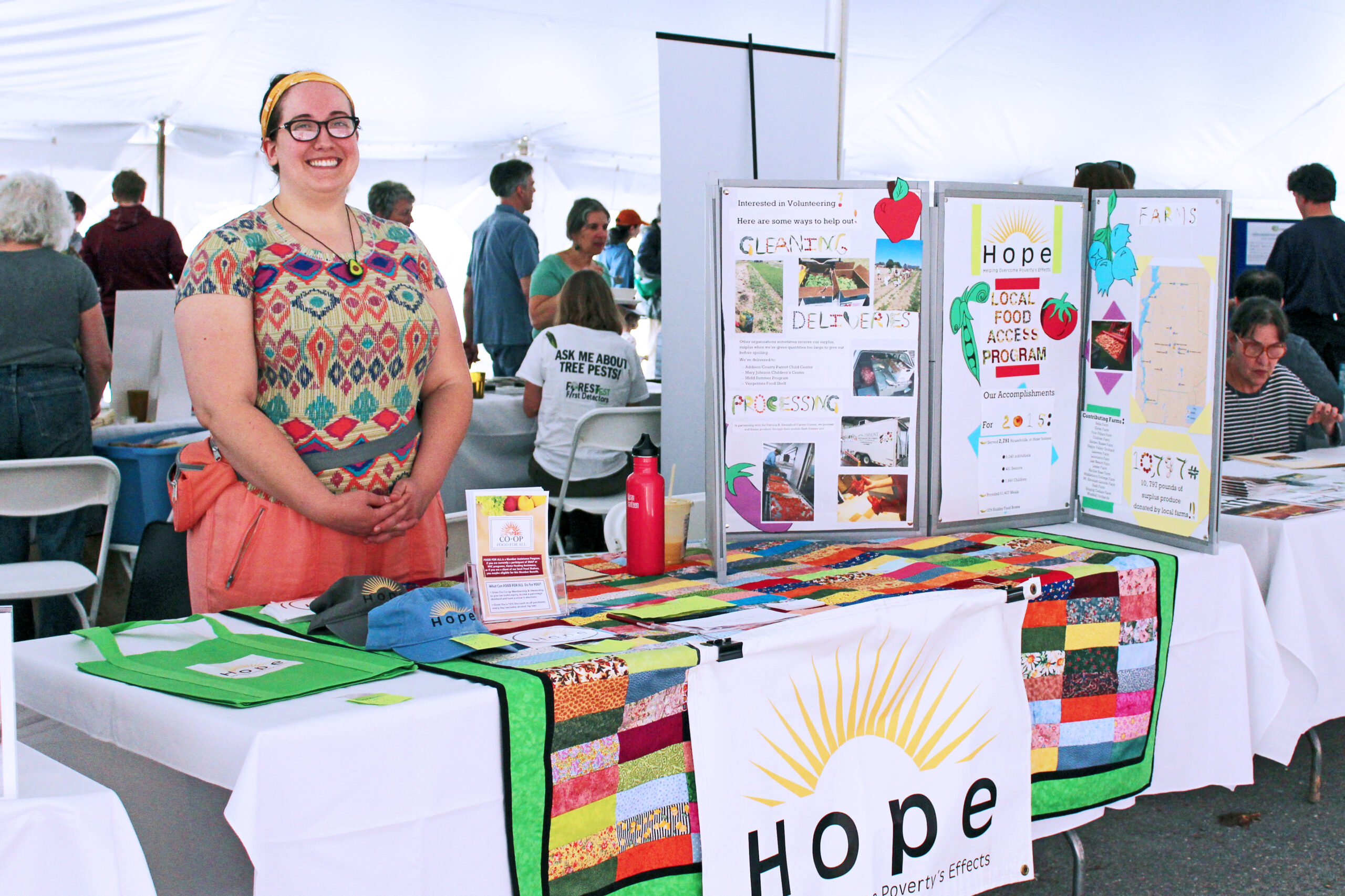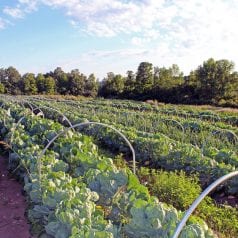
Vermont’s Local Food System: A Report Card – Part 3
At a recent meeting of the Addison County Hunger Council, three representatives offered interesting perspectives regarding Vermont’s local food systems, and shared the successes and challenges associated with serving each particular group they represented. The Council explored issues throughout the local food system, from the farm workers who produce the food, to the distribution system for getting food to those who need it most. Council members discussed available resources, what supports are necessary, and what opportunities are present.
The representatives sharing presentations were Dr. Teresa Mares of UVM, Lily Bradburn of HOPE, and Jonathan Corcoran of ACORN. Dr. Mares shared insights about how our local food system serves the growing migrant farm worker population in Vermont (see Part 1). Lily Bradburn spoke about how these systems serve members of our community who are food insecure (see Part 2), and Jonathan Corcoran discussed local food system goals and challenges for our community as a whole. Here at the Co-op, we spend a lot of time thinking about local food and the systems that support it, though it was very interesting and unique to examine it though the lens of these diverse groups of people. Through a three-part review of these presentations, we hope to share what we learned with all of you. In this third and final installment, we’ll explore the work being done by ACORN to increase local food access and strengthen our local food system as a whole:

Why is local food so important to Vermonters?
Vermont’s food system is critical to our economy, identity, quality of life, and sustainability. From 2007 to 2012 (the last year this data was available) food system economic output expanded 24%, from $6.9 billion to $8.6 billion. Over 60,000 Vermonters are directly employed in Vermont’s food system. From 2002 to 2013, food system employment increased by 5,589 jobs (9.9%). Most of those jobs were created after the Great Recession—4,189 jobs were created from 2009 to 2013. Vermont’s dairy industry brings $2.2 billion in economic activity annually, and a wide range of non-dairy farms of all sizes also produce conventional and organic fruits and vegetables, livestock, hay, maple products, and specialty crops for local, regional, and national markets. Vermont’s dynamic and evolving food system is also made up of entrepreneurs creating a variety of value-added products (e.g., cured meats, baked goods, beer, chocolate); thousands of market outlets; sophisticated distribution networks; and dozens of organizations, programs, and volunteer-driven activities that provide business planning, technical assistance, education, and outreach activities. Nearly 12,000 businesses are part of Vermont’s food system. When measured by employment and gross state product, food manufacturing is the second-largest manufacturing industry in Vermont. (Source: Vermont Farm to Plate Strategic Plan)
What role does ACORN play?
ACORN (Addison County Relocalization Network) is a 501(c)(3) non-profit community organization based in Middlebury, whose mission is to promote the growth and health of local food and agriculture in Vermont’s Champlain Valley. To raise community awareness and support for local foods, ACORN connects with over 2,800 people via emails and newsletters, and organizes many local events aimed at fostering a connection between area farmers & producers and the community they nourish. They organize the annual Stone Soup Summit to bring together farmers, food service providers, teachers, administrators, healthcare professionals, parents, students, representatives from Middlebury College, local nonprofits, and other community members to generate and cultivate connections, and raise enthusiasm for Farm-to-School programming.
Another major ACORN event is the annual Tour de Farms: a cycling tour of our county exploring 25 participating farms, food businesses and restaurants. Participants can choose the full 30-mile route, a 14-mile family-friendly route, or those who don’t ride bikes may opt to ride on the Farm Bus. The event culminates with an after party featuring live music and an abundance of local ice cream, food and drinks. Approximately 3000 people have participated in Tour de Farms over the past 8 years, and the 2016 Tour de Farms is just around the corner on Sunday, September 18th.


In addition to events like the Tour de Farms, ACORN also publishes the Champlain Valley Local Food and Farm Guide, which helps connect consumers with over 200 area farms focused on small, diversified production. They work with farm-to-school groups, local food service companies, and the Harvest of the Month program to encourage education around seasonal eating and healthy food choices. ACORN has been working to help Middlebury College increase their local food procurement, which has been a slowly moving process but is seeing some positive starts. Additionally, ACORN tracks the amount of local purchasing already happening – our Co-op is the largest in the area, followed by Middlebury College, Porter Medical Center and ANESU Foodservice Cooperative. ACORN plans to track purchasing for all area elementary, middle, and high schools for the 2016-2017 school year, and is encouraged that nearly every school in the County now has a school garden.

Challenges and Solutions
Jonathan and his colleagues at ACORN are trying to increase the amount of local food available in the region, but are challenged by the small-scale production models of many farms as well as the lack of local markets that could support more local food production. Jonathan referenced the ambitious goals of the Farm to Plate initiative devised by the Vermont State Legislature, which aims to strengthen Vermont’s local food system and increase local food production and consumption by increasing the number of acres in food production, the diversity of foods produced, and the overall amount of food produced in Vermont. Jonathan explained that while Addison County is well situated for food distribution, we lack the necessary infrastructure.
One potential solution could come in the form of a burgeoning area food hub – The Vermont Farmers Food Center (VFFC) in Rutland . The VFFC began as a grassroots, volunteer-led project and is spearheading the rebuilding of infrastructure necessary for agriculture to serve as a regional economic engine through the development of 2.93 acres of industrially zoned land with four existing buildings in the heart of Downtown Rutland. VFFC will increase access and availability of locally produced food in the region by expanding markets and market access, aggregation, and distribution of locally produced and value-added agricultural products. Jonathan expressed hope that this new venture could help bridge the infrastructure gap that is preventing our region from reaching its potential with regard to local food production and distribution.
An additional challenge to increasing local food consumption cited in Jonathan’s presentation is the recent boom of mail-order food businesses. As explained in a recent New York Times article, CSA (Community Supported Agriculture) subscriptions are experiencing a steady decline as many consumers opt for online subscriptions which market themselves as CSAs, but lack any of the direct support to local farms that true CSAs provide. Even those online food subscriptions that are not masquerading as CSAs come with a side dish of collateral damage to the local food system. They offer to take the guesswork out of meal planning and preparation by providing the convenience of a pre-packaged, pre-measured set of ingredients and a recipe delivered to your doorstep. This sounds ideal until one considers that the ingredients in the box aren’t coming from a local farmer or producer, they’ve traveled many miles and consumed many resources to reach you, they don’t reflect a seasonal approach to food choices, and when a consumer doesn’t have to chop, measure, or think about the food they’re preparing, this meal-in-a-box serves to broaden the disconnect between consumers and their food.
If Vermont is to succeed in meeting the goals of the Farm to Plate initiative and build a strong, resilient regional food system, consumers will need to play their part by continuing to support local farmers and producers with their food dollars whenever possible. This can prove to be a significant challenge for those living on a tight food budget, though Jonathan expressed encouragement with the work being done locally by folks like Lily Bradburn at HOPE to increase access to healthy, local foods for those with limited means. Additional solutions to this challenge can come from programs like Food For All, offered by many area co-ops, or Crop Cash, which provides an incentive program for 3SquaresVT / SNAP recipients to use their benefits at farmers’ markets, essentially allowing them to double their money when they choose to spend it on local fruits and vegetables from local farmers.
We are extremely grateful for the efforts being made by Jonathan and his colleagues at ACORN to strengthen our local food system and appreciate the way they examine the local food puzzle from every possible angle. Will we reach the goals of the Farm to Plate initiative by 2020? Thanks to organizations like ACORN & the Vermont Farmers Food Center, along with consumers like you who choose to support local foods, we’ll certainly give it our best effort.


